This Pan-Seared Filet Mignon is restaurant-caliber dining in the comfort of your own home. Steaks are seared in butter until well-browned, then served with a red wine-dijon mustard sauce.
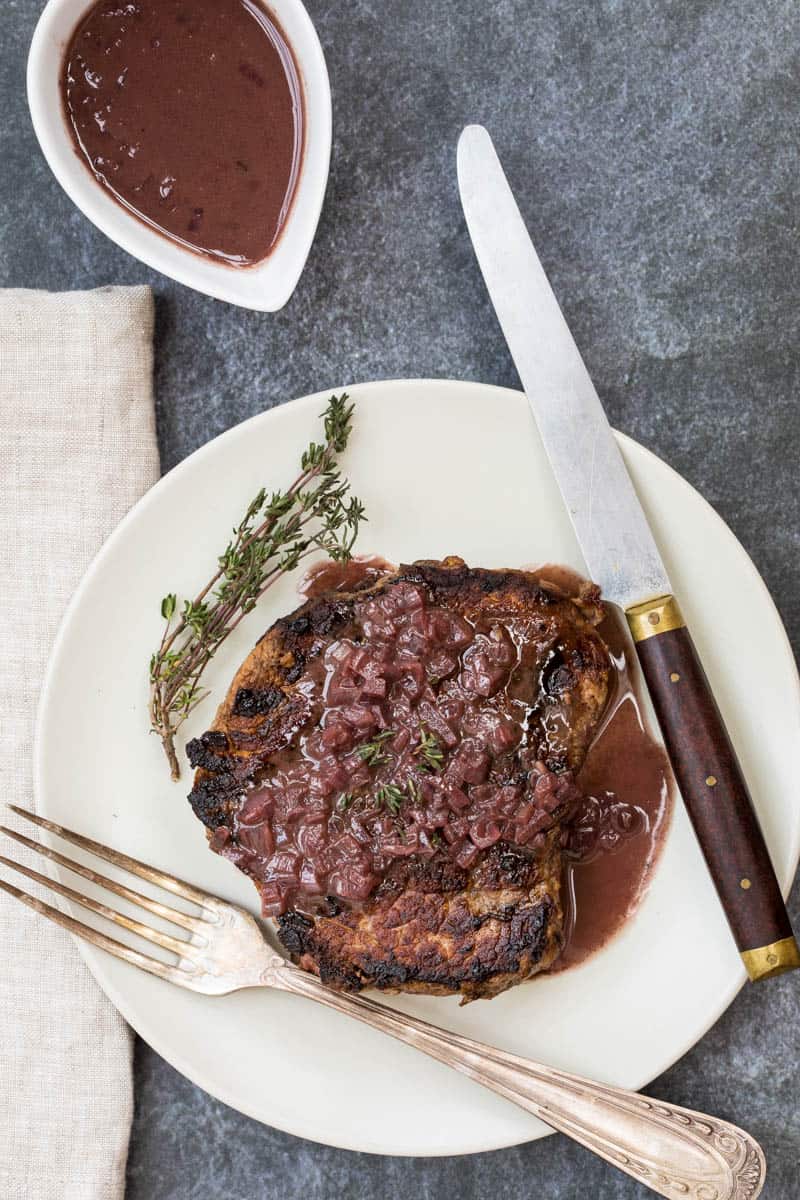
Why Make This Recipe
- Perfect for a special meal. Why go out to a fancy restaurant, when you can make this pan-seared filet mignon at home? So very elegant and delicious. The rich red wine sauce puts this recipe over the top.
- Easier than you’d think. If cooking filet mignon at home intimidates you, this is a perfect starter recipe. And, it uses only one skillet for both the steaks and the sauce, so cleanup is easy!
- Classic French flavors. I love the flavors in this dish—along with the steak, this recipe uses traditional French ingredients including red wine, butter, shallots, dijon mustard, and thyme. The combination will make you think you’re in a Paris bistro!
🥗 Ingredients

- Filet mignon steaks: In the United States, the term filet mignon is used to describe individual steaks cut from a beef tenderloin. However, in France the term “filet mignon” generally refers to a pork or veal tenderloin. For this recipe, you can either use precut steaks from your butcher or you can slice your own steaks directly from a beef tenderloin. For best results, look for steaks that are about 1.5-inches thick.
- Shallots: You can replace these with red onion if you don’t have shallots.
- Butter: I’d recommend using unsalted butter for this dish, so that you can control how salty the finished sauce is by adding your own salt. If you wanted to reduce the calories a little, you could use olive oil to brown the steaks rather than butter. But butter is really essential for a silky red wine sauce!
- Red Wine: I’d recommend a red wine on the fruity side, such as a Merlot or a Pinot Noir. Stay away from red wines that are very tannic, such as Cabernet Sauvignon. And always choose something that you'd like to drink, though you don't need to splurge on an expensive bottle.
- Thyme: If you don’t have thyme, rosemary would also be a delicious herb to use in this dish.
🥣 Instructions
Sprinkle filet mignon steaks on both sides with kosher salt and freshly ground black pepper. Peel and finely chop 2 large shallots. Cut 2 tablespoons of butter into small dice, and refrigerate.
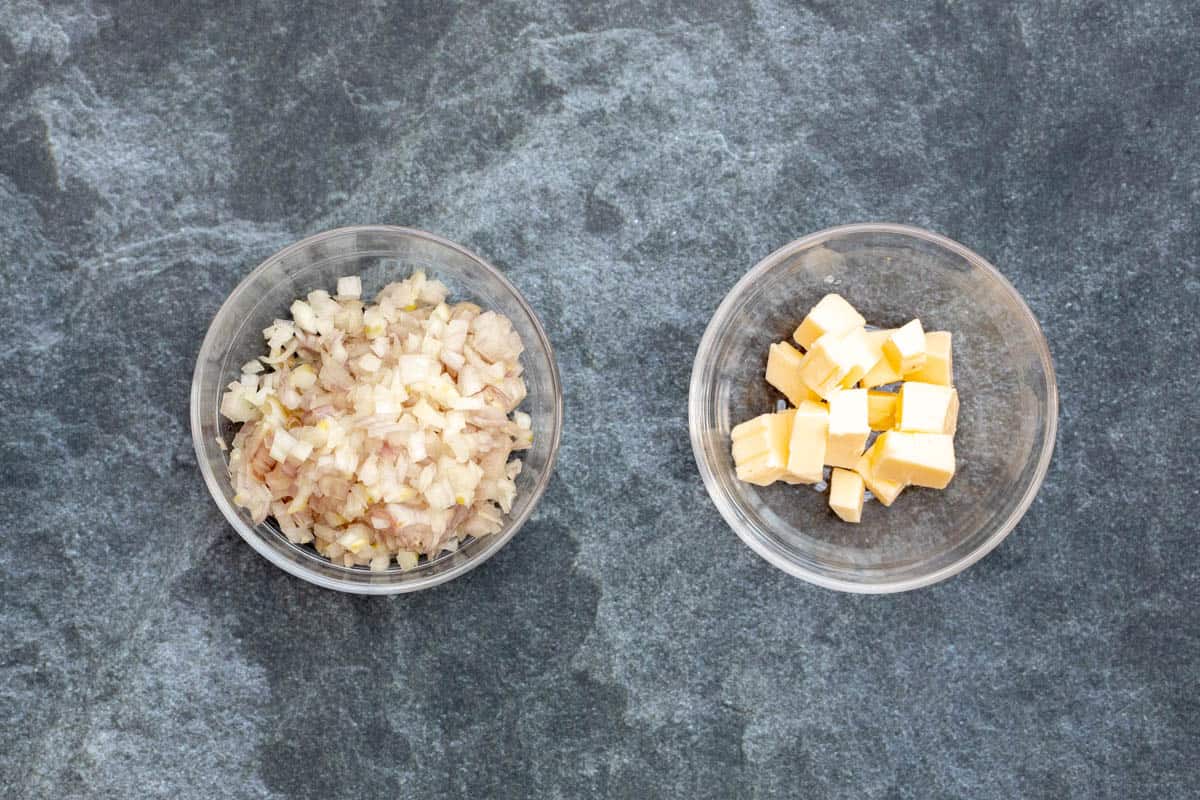
If you have steaks thicker than 1.5 inches, turn the oven on to 400 degrees Fahrenheit (200 degrees Celsius) just in case. Heat large heavy nonstick skillet over medium-high, and add 1 tablespoon butter. When butter melts, add steaks.
Cook 4-6 min on each side for medium-rare (about 130-135 degrees Fahrenheit/54-57 degrees Celsius). Testing with a high-quality meat thermometer at this point is highly recommended.
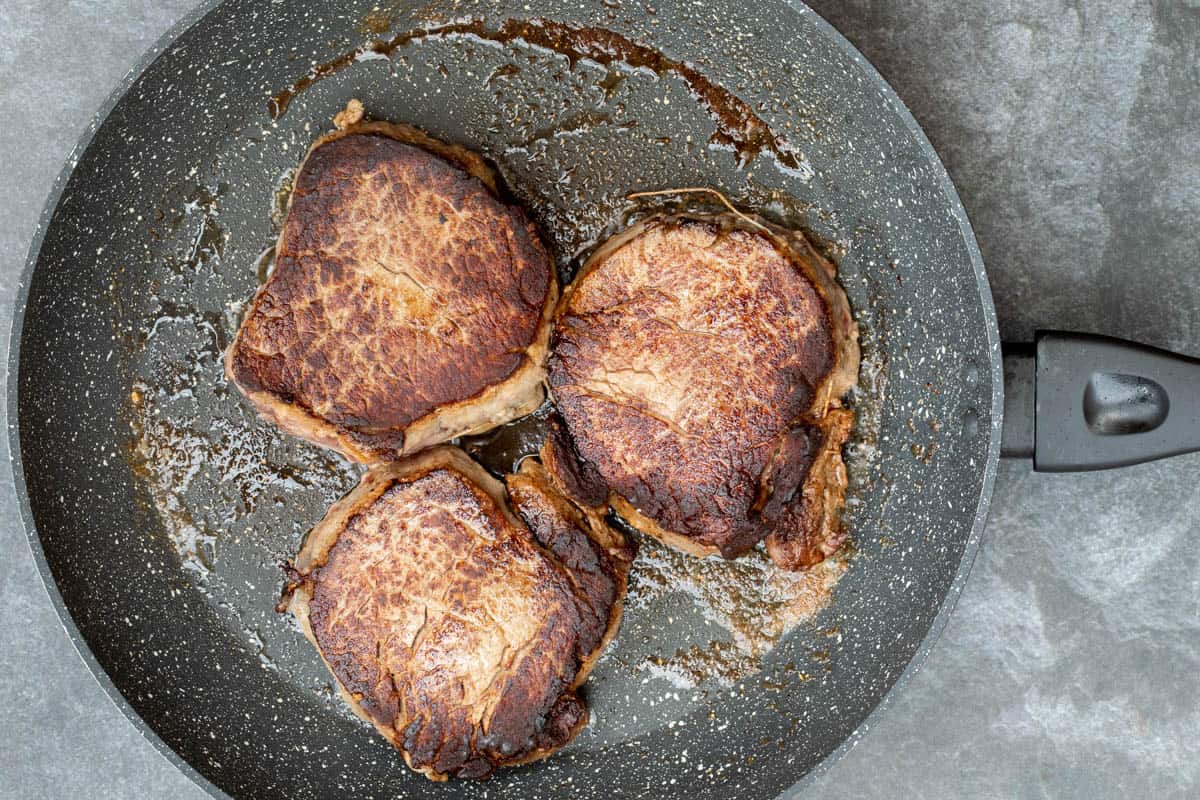
If your steaks are not cooked to medium-rare by this point, move the skillet into the oven if you are using an oven-safe skillet (or move steaks to a baking sheet) and roast for 5 minutes or until they reach the temperature you are looking for.
When steaks are done to your liking, put on a plate and cover with foil.

Turn skillet heat down to medium. Add another 2 tablespoons of butter, stir until melted, then add chopped shallots. Cook until softened and lightly browned, stirring often, about 2-3 minutes.
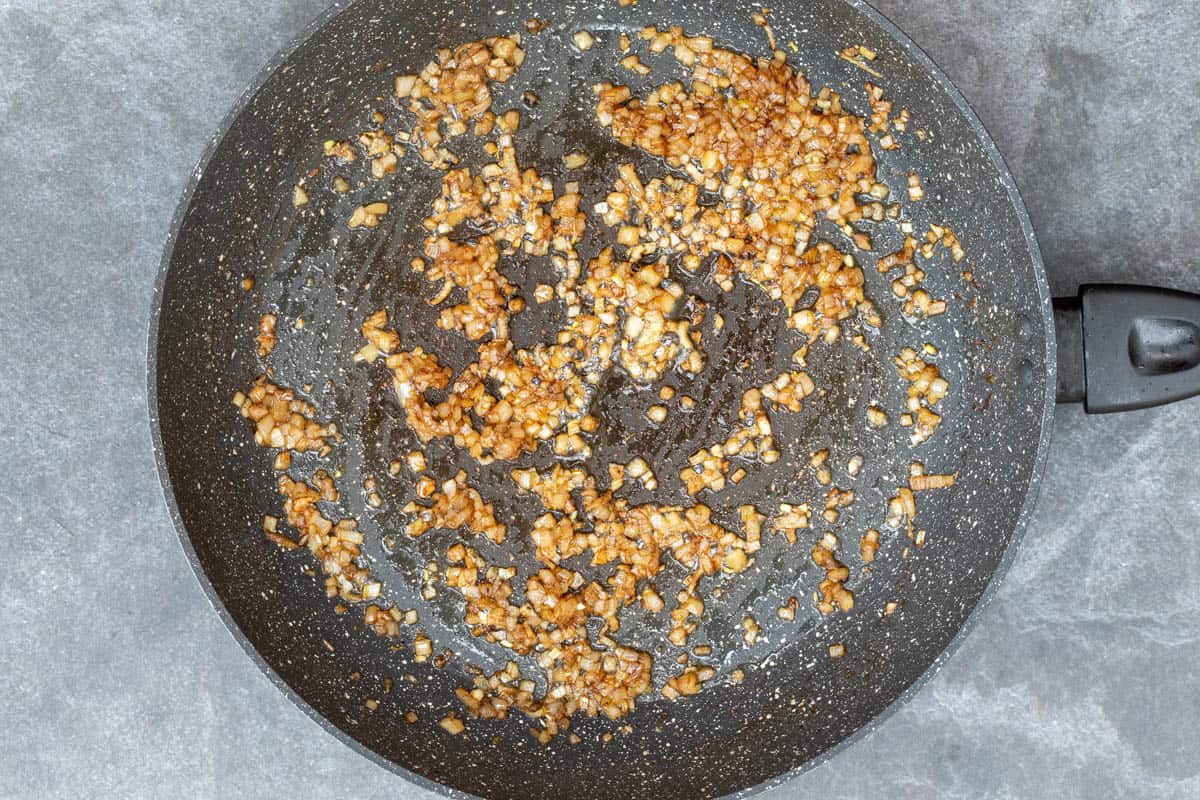
Then add 1 cup red wine, 1 teaspoon dijon mustard, 2 thyme sprigs, and a crushed garlic clove. Pour any juices under the steaks on their plate into the wine sauce.

Turn up heat to medium-high and simmer until thickened, 3 min. Remove thyme sprigs and garlic clove. Turn down heat to medium and whisk in the cold butter, a couple of cubes at a time, until you have a smooth sauce.

Season sauce with salt and pepper. Serve steaks with sauce on top, garnished with chopped fresh thyme.
🧐 Recipe FAQs
I recommend cooking filet mignon to a medium-rare temperature, or about 130-135 degrees Fahrenheit (54-57 degrees Celsius). If you like your steak more towards medium, you can cook it up to 145 degrees.
For a cut like filet mignon though, I really wouldn’t go higher than that—there’s something magical about that pink-red middle that is oh-so-tender.
If you prefer your steaks well done, save your money and buy a cheaper cut of steak! Also, keep in mind that steak will continue to rise in temperature about 3 degrees after being removed from the pan or the oven.
Steaks should always rest for 5-10 minutes after cooking. This allows the juices to be reabsorbed throughout the steak, so that they don’t run out the minute you cut the steak.
This recipe has the resting time built-in because the steak rests while you make the sauce. For a great description of just what’s happening when you rest a steak after cooking see this article on the importance of resting meat by The Food Lab.
The best skillet to pan-sear steaks is a large, heavy skillet. Heavy skillets generally conduct heat better than lightweight skillets, and having a large one will help make sure there is enough space between each filet.
You can use either a nonstick skillet or a well-seasoned cast-iron skillet. The benefit of a cast-iron skillet is that if your steaks are very thick and you need to finish them in the oven, you can put the skillet directly in there.
👩🍳 Expert Tips
I highly recommend using a quick-read meat thermometer for this pan-seared filet mignon. My favorite is the Thermapen One (sponsored but only because I love it!), which gives you fast and accurate results. Yes, it is pricey, but what a waste of money to overcook a beautiful piece of filet mignon!
Note that cooking steaks over high heat with butter can get smoky. Turn on your stovetop fan before you start cooking and/or open windows for ventilation (if possible). If your kitchen tends to get really smoky, just do a quick sear on each side, then finish cooking in the oven.
One of the keys to getting a good sear on your steak is to make sure it is quite dry when it hits the pan. Pat your filets as dry as possible with a paper towel before adding the salt and pepper. Or, you can salt your steak 24 hours before using, then place it (unwrapped) on a rack in the refrigerator. The outside will dry out and give you a great sear when you cook it.
Want to try another delicious steak recipe? This Blackened Steak recipe gives you steakhouse flavor at home.

Delicious Side Dishes
Wondering what to serve with this pan-seared filet mignon? Why not try a simple side like Roasted Mini Peppers or Roasted Red Onions? Or get fancy with Roasted Artichokes?
We also love this steak dish with this classic Garlic and Rosemary Potatoes side. So delicious! In the winter, adding a Beet and Feta Salad works well.
And here are some other favorites:
And of course, you can find a whole archive of Side Dishes here. And don't forget dessert. A romantic steak dinner is perfection when paired with this Vanilla Bean Crème Brûlée.

If you try this recipe, I would love to hear from you! Leave a comment below—I read them all, and your feedback is invaluable to me.
And please follow along on Instagram, Pinterest, and Facebook or subscribe to my newsletter. I'd love to inspire you with more delicious, healthy, and seasonal recipes!
Want to Save This Recipe?
Enter your email & I'll send it to your inbox. Plus, get great new recipes from me every week!
By submitting this form, you consent to receive emails from Vanilla Bean Cuisine.
📖 Recipe

Pan-Seared Filet Mignon with Red Wine Sauce
Restaurant-caliber food in the comfort of your own home! Steaks are seared in butter until well-browned, then served with a red wine-dijon mustard sauce.
Ingredients
- 4 filet mignon/beef tenderloin steaks (1.5 inches thick/around 8 oz. each)
- 2 large shallots, about 3 oz. total
- 5 T. unsalted butter (2.5 oz.)
- 1 cup red wine (8 oz.)
- 1 t. dijon mustard
- 2 thyme sprigs, plus chopped thyme for garnish
- 1 garlic clove, crushed
- Kosher salt
- Freshly ground black pepper
Instructions
- Pat steaks dry, then sprinkle both sides with kosher salt and freshly ground black pepper. If your steaks are thicker than 1.5 inches, preheat oven to 400 degrees Fahrenheit (200 degrees Celsius).
- Peel and finely chop shallots.
- Cut 2 tablespoons of butter into small dice, and refrigerate.
- Heat large heavy nonstick skillet over medium-high, and add 1 tablespoon butter. When butter melts, add steaks.
- Cook 4-6 min on each side for medium-rare (about 130-135 degrees Fahrenheit/54-57 degrees Celsius on a meat thermometer). If you have thick steaks, and they are not cooked to your liking by this point, put them into the oven and roast for another 3-5 minutes.
- Remove steaks onto plates and cover with foil.
- Turn down skillet heat to medium. Add another 2 tablespoons of butter, stir until melted, then add chopped shallots.
- Cook until softened and lightly browned, stirring often, about 2-3 minutes.
- Then add red wine, dijon mustard, thyme sprigs, and crushed garlic clove. Pour any juices under the steaks on their plate into the wine sauce.
- Turn up heat to medium-high and simmer until thickened, 3 min.
- Remove thyme sprigs and garlic clove.
- Turn down heat to medium and whisk in the cold butter, a couple of cubes at a time, until you have a smooth sauce.
- Season sauce with salt and pepper.
- Serve steaks with sauce on top, garnished with fresh chopped thyme.
Notes
- Red Wine: I’d recommend a red wine on the fruity side, such as a Merlot or a Pinot Noir. Stay away from red wines that are very tannic, such as Cabernet Sauvignon.
- I highly recommend using a quick-read meat thermometer for this dish. My favorite is the Thermapen (not sponsored), which gives you fast and accurate results. Yes, it is pricey, but so is overcooking a beautiful piece of filet mignon!
- Note that cooking steaks over high heat with butter can get smoky. Turn on your stovetop fan before you start cooking and/or open windows for ventilation (if possible). If your kitchen gets really smoky, just do a quick sear on each side, then finish cooking in the oven.
- The best skillet to pan-sear steaks is a large, heavy skillet. Heavy skillets generally conduct heat better than lightweight skillets, and having a large one will help make sure there is enough space between each filet. You can use either a nonstick skillet or a well-seasoned cast-iron skillet. The benefit of a cast-iron skillet is that if your steaks are very thick and you need to finish them in the oven, you can put the skillet directly in there. Otherwise, move your steaks to a sheet pan to finish cooking in the oven.
Nutrition Information:
Yield: 4 Serving Size: 1Amount Per Serving: Calories: 560Total Fat: 35gSaturated Fat: 17gTrans Fat: 0gUnsaturated Fat: 14gCholesterol: 139mgSodium: 344mgCarbohydrates: 22gFiber: 3gSugar: 6gProtein: 30g
Nutrition information is provided as a general reference for users courtesy of the online nutrition calculator Nutritionix.
Instagram Users: Now that you've made this pan-seared filet mignon recipe, tag me @vanillabeancuisine or #vanillabeancuisine because I'd love to see your results!


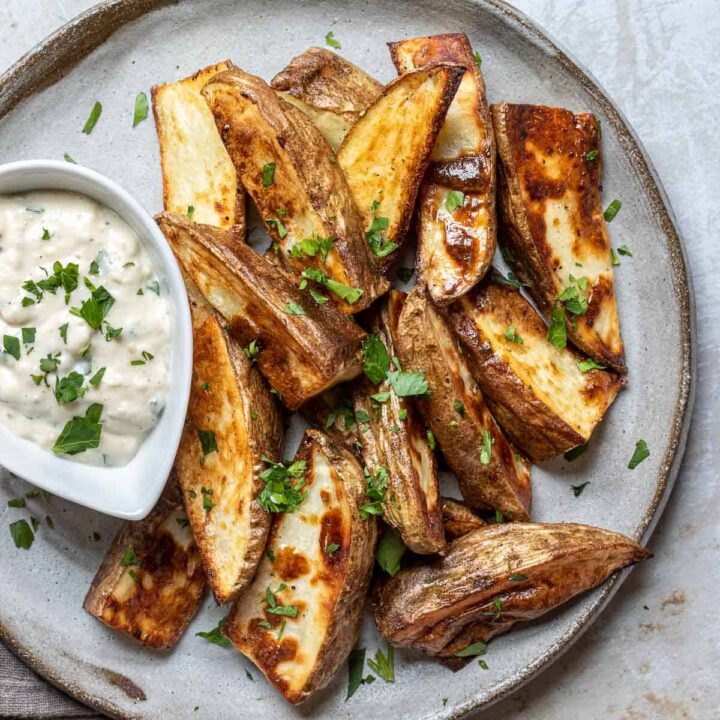
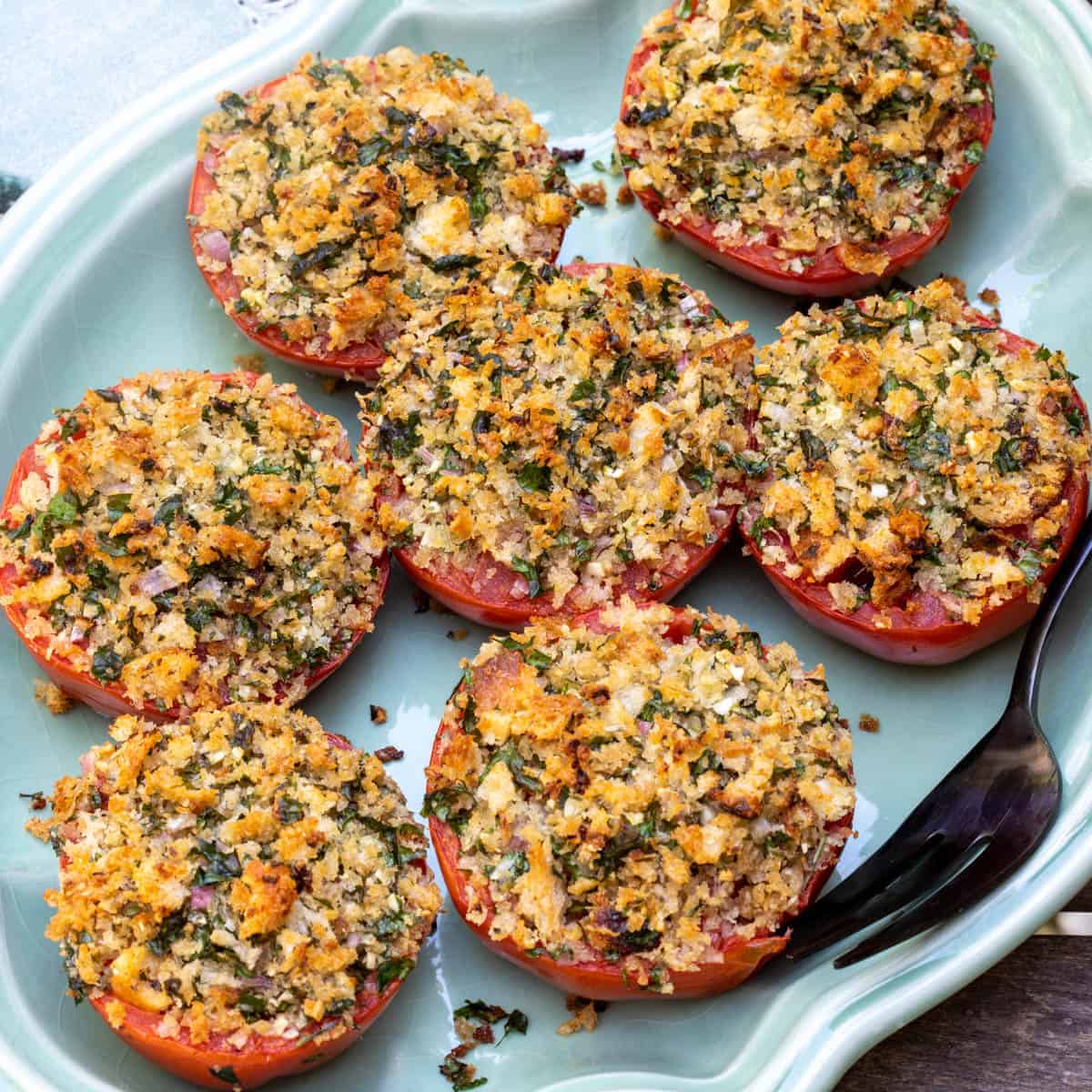



Laurel Kenny says
This recipe is soooooo delicious. I seriously wanted to lick the remainder of the sauce off my plate. What a brilliant way to cook a filet as well, without using our grill. Thanks, Molly for all of your wonderful recipes. They have been game changers to my weekly menus!!
Chef Molly says
Thanks Laurel! So glad you enjoyed this recipe--I love that red wine sauce so much, I would totally approve sauce-licking. 🙂
Katerina says
I agree - this is definitely a special occasion worthy and looks much better than from a restaurant. I bet that red wine gravy is just delicious! Beautifully done, Molly!
Chef Molly says
Thank you! That red wine sauce really does make the dish!
Heidi | The Frugal Girls says
I loved your use of butter to prepare this steak... and your red wine sauce is simply outstanding. Who needs to head to a steakhouse when we can simply use your lovely recipe instead!?!
Chef Molly says
Thanks Heidi! Yes, no need for a steakhouse. And even with the butter in the red wine sauce, I'd bet this recipe is tons healthier than what you'd get in a restaurant. And just as delish!